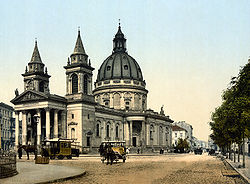- Places of worship in Warsaw
-
 St. Alexander's Church prior to destruction in World War II, c. 1890-1900.
St. Alexander's Church prior to destruction in World War II, c. 1890-1900.
This article is a list of places of worship in Warsaw, Poland, both current and historical. It includes Catholic, Uniate, Protestant and Orthodox churches, as well as synagogues and shrines of other denominations. Note that the list includes also places of worship that were destroyed some time in the past and are currently non-existent. Throughout its existence, Warsaw has been a multi-cultural city.[1] According to a census of 1901, out of 711,988 inhabitants there were 56,2% Catholics, 35,7% Jews, 5% Greek orthodox Christians and 2,8% Protestants.[2] Eight years later, in 1909, there were 281,754 Jews (36,9%), 18,189 Protestants (2,4%) and 2,818 Mariavites (0,4%).[3] This led to construction of hundreds of places of religious worship in all parts of the town. Most of them were destroyed in the aftermath of the Warsaw Uprising of 1944. After the war the new communist authorities of Poland discouraged church construction and only a small part of them were rebuilt.[4]
The cathedrals and other main places of worship are bolded, non-existent churches are listed in italics.
Contents
Christian
Catholic
- St. Alexander's Church on Plac Trzech Krzyży
- St. Ann's Church at Krakowskie Przedmieście, serving the academic community
- St. Anne's Church in Wilanów
- St. Augustine's Church
- Capuchins Church at Miodowa Street
- Carmelite Church
- St. Casimir's Church
- St. Catherine's Church
- Church of the Holiest Saviour at the square of the same name
- Field Cathedral of the Polish Army
- St. Florian's Cathedral in the eastern borough of Praga
- St. Francis' Church
- Shrine of God's Providence in Wilanów (under construction since 1791)
- Holy Cross Church on Krakowskie Przedmieście
- Holy Ghost's Church
- St. John's Cathedral
- St. Martin's Church
- National Temple of Divine Providence (under construction)
- Visitationist Church and convent
Orthodox
- St. Mary Magdalene's Cathedral
- Alexander Nevsky Cathedral at the Saxon Square (non-existent)
- St. John Klimak's Church at the Orthodox part of the Powązki Cemetery
- St. Peter and Paul's Church in Wołomin
- Chapel of the Holy Mary Mother of God at Paryska street
Protestant
- Anglican Church of Warsaw in Krakowskie Przedmieście
- Methodist Chapel at Plac Zbawiciela
- Calvinist Parochial Church
- Lutheran Holy Trinity Church (so-called Zug's Church)
- Pentecostal Church (Zbór Stołeczny)
- Seventh Day Adventist Church
- Baptist Church
- International Christian Fellowship, Warsaw
Uniate
- Church of the Ascension of the Holy Mary of the Basilian monks at Miodowa street
Jewish
- Great Synagogue (non-existent)
- Nożyk Family Synagogue, the only synagogue to be rebuilt after the war
- Beit Warszawa Synagogue
- Chabad Lubavitch Synagogue
Muslim
- Centre of Islam at Wiertnicza street
- Muslim House of Prayer in the Iraqi embassy (non-existent)
See also
- Tourist attractions in Warsaw
References
- ^ (English) Geert Mak (2008). In Europe: travels through the twentieth century. Pantheon Books. p. 427. ISBN 03-07280-57-8. Today Warsaw is a monocultural city, which is some people's ideal. But before 1939 it was a typically multicultural society. Those were the city's most productive years. We lost that multicultural character during the war.
- ^ (German) Hermann Julius Meyer (1909). Meyers Konversations-Lexikon. 20 (6 ed.). Leipzig and Vienna. p. 388.
- ^ (German) Erich Zechlin (1916). Die Bevölkerungs- und Grundbesitzverteilung im Zartum Polen (The distribution of population and property in tsaristic Poland). Reimer, Berlin. pp. 82–83.
- ^ (English) Marian S. Mazgaj (2010). Church and State in Communist Poland: A History, 1944–1989. McFarland. p. 67. ISBN 07-86459-04-2.
Categories:
Wikimedia Foundation. 2010.
